Development of Competitive Advantage Business Model for Crane Business in Thailand
Keywords:
Business Model, Development of Competitive Advantage, Crane BusinessAbstract
The purpose of this research aimed to determine development of competitive advantage business model for Crane business in Thailand. To find the level of important factors and strategy in the success of crane business. To compare the basic of general personal appearance of respondents with the level of importance factors in the success of crane business. Finding the relationship between the level of importance factors in the success of crane business and the strategy to create competitive advantage of crane business. Offering a model to create a competitive advantage of crane business. The overall 385 sampling sizes were chosen and utilized the questionnaires as the study tool for this quantitative study. The descriptive and inferential statistics used for data analysis of percentage, mean, standard deviation, T-test, Pearson Correlation, One-way Anova, and least significant different.
Findings revealed that most of respondents were males (67%), age between 36-45 years old (40%), majority of bachelor degree graduated (57%), managerial positions (43%), work experience for a period of 6-10 years (41%), monthly income between 30,000-40,000 baht (31%), and selfemployed (52%). The overall picture of their opinions on the level of important factors in the success of crane business was in high level when considered each aspect ascost, on time delivery, and trust worthy of crane business owners. As for factors of quality of the service was in the medium level. The overall picture of their opinions on strategy in the success of development of competitive advantage of crane business in Thailand was in high level with the following reasons; differentiate strategy, and focusing on each aspect. As for low cost leader operators was in medium level. The hypothesis testing revealed that the factors of personal different as gender, age, level of education, monthly income, and work duration would affection strategy in the success of development of competitive advantage of crane business with a statistical significant 0.05 level. In addition, the overall picture of strategy of development of competitive advantage of Crane business in Thailand in relation to factors in the success of crane business was in medium level in same direction. Furthermore, crane service quality related to the level of important factors in the success of crane business was in high level in same direction. In addition, other aspects which related to factors in the success of crane business was in medium level in same direction.
Recommendation from this research was entrepreneurs should create brand name, build crane business alliance all around the country to save delivery costs, and prepare strategy for AEC market.
References
คำนาย อภิปรัชญาสกุล. (2556). การจัดการคลังสินค้าในงานโลจสิตกิส์ กรุงเทพฯ : สำนักพิมพ์ โฟกัสมีเดีย แอน พับลิชชิ่ง.
ไชยยศ ไชยมั่นคง, มยุขพันธ์ ชัยมั่นคง. (2550). กลยุทธ์โลจิสติกส์และซัพพลายเช่นเพื่อแข่งขันในตลาดโลก, กรุงเทพฯ : บริษัท ดี.เค. ทูเดย์ .
ไชยยศ ไชยมั่นคง, มยุขพันธ์ ชัยมั่นคง. (2556). การจัดการโลจิสติกส์ : มิติซัพพลายเขน. กรุงเทพฯ : สำนักพิมพ์ วิชั่น พรีเพรส.
ฐาปนา บุญหล้า,นงลักษณ์ นิมิตรภูวดล. (2555). การจัดการโลจิสติกส์ : มิติซัพพลายเขน. กรุงเทพฯ : สำนักพิมพ์ ซีเอ็ด.
ทัศนา แขมมณีและคณะ. [ม.ป.ป.]. การวิจัยและพัฒนารูปแบบการปฏิบัติรูปการเรียนรู้ทั้งโรงเรียน. คณะครุศาสตร์ จุฬาลงกรณ์มหาวิทยาลัย.
ทิพย์วรรณ เตมียกุล. (2545). รายงานการใช้และหาประสิทธิภาพชุดการเรียนการสร้างโจทย์ปัญหาจากชีวิตประจำวัน วิชาคณิตศาสตร์ ชั้นประถมศึกษาปีที่ 5 สิงห์บุรี : โรงเรียนวัดพรหมสาคร.
เทียนฉาย กีระนนท์. (2541). สังคมศาสตร์วิจัย. พิมพ์ครั้งที่ 4. กรุงเทพมหานคร : ศูนย์หนังสือจุฬาลงกรณ์มหาวิทยาลัย.
บุญสิตา กิติศรีวรพจน์ . (2554). การคัดเลือกผู้ให้บริการโลจิสติกส์ของบริษัทฮานาไมโครอิเลคโทรนิกส์จำกัด (มหาชน) เขตอุตสาหกรรมภาคเหนือโดยกระบวนการตัดสินใจแบบวิเคราะห์ลำดับชั้นและทฤษฎีฟัซซีเซต วิทยานิพนธ์ บริหารธุรกิจมหาบัณฑิต มหาวิทยาลัยเชียงใหม่.
ประพันธ์ รุจิรอาภากร และคณะ.(2546). ” Outsourcing Logistics Activities in Pharmaceutical Industry in Thailand.“ วารสารนวัตกรรมทางเทคโนโลยีและเทคนิคการจัดการเพื่อโซ่อุปทานที่มีศักยภาพในการแข่งขัน. หน้า 41-55.
พัชนพ ตันพิชัย และวิโรจน์ ศรีสุรภานนท์. (2545). ” แนวทางการพัฒนาประสิทธิภาพในการขนส่งโดยใช้ความร่วมมือในการประกอบการ. “วารสารการขยายแนวปฏิบัติที่ดีที่สุดในการจัดการโลจิสติกส์และโซ่อุปทานสำหรับประเทศไทย. หน้า 95 - 102.
วรากรณ์ ทองเก๋ง. (2551). ปัจจัยที่มีอิทธิพลต่อประสิทธิภาพการให้บริการโลจิสติกส์การขนส่งทางบกด้วยโลจิสติกส์ แบบลีนของกลุ่มสมาคมตัวแทนขนส่งสินค้าทางอากาศไทย. วิทยานิพนธ์บริหารธุรกิจมหาบัณฑิต สาขาบริหารธุรกิจ มหาวิทยาลัยราชภัฏพระนคร.
วรวิทย์ จุลนวล. (2551). วิเคราะห์ตลาดส่งออกเครื่องเทศไทยใช้ดัชนีความได้เปรียบเชิงเปรียบเทียบที่ปรากฏและการวิเคราะห์ส่วนแบ่งตลาดคงที่. วิทยานิพนธ์การจัดการมหาบัณฑิต สาขาเทคโนโลยีการจัดการ มหาวิทยาลัย เทคโนโลยีสุรนารี.
ศิริวรรณ เสรีรัตน์ และคณะ.(2551). การบริหารการตลาดยุคใหม่. สำนักพิมพ์พัฒนาศึกษา.กรุงเทพมหานคร
สุรกิจ จันทร์แสงศรี. (2550). กลยุทธ์การสร้างความได้เปรียบทางการแข่งขันของธุรกิจจำหน่ายวัสดุก่อสร้างจังหวัด มหาสารคาม. บริหารมหาบัณฑิต สาขาการตลาด มหาวิทยาลัยมหาสารคาม.
อุทุมพร จามรมาน.(2543). ” ดัชนีประเมินและเกณฑ์ตัดสินคุณภาพภายในสถานศึกษา " กรุงเทพมหานคร :สำนักงานพัฒนาและประกันคุณภาพการศึกษา สถาบันพัฒนาคุณภาพวิชาการ, 2543. (อัดสำเนา)
เอกลักษณ์ กู้เกียรติวงศ์ . (2552). ปัจจัยที่ส่งผลประสิทธิภาพด้านการจัดการโลจิสติกส์ของอุตสาหกรรมน้ำมันพืช วิทยานิพนธ์บริหารธุรกิจมหาบัณฑิต สาขาบริหารธุรกิจ มหาวิทยาลัยราชภัฎพระนคร.
Keeves John P. (1988). Educational research, and methodology, and measurement: An international handbook. Oxford: Pergamon Press.
Smith E. W.et. (1965). The education's encyclopedia. New York: Prentice-Hall, 1965.
Downloads
Published
Issue
Section
License
บทความที่ได้รับการตีพิมพ์เป็นลิขสิทธิ์ของ สถาบันวิทยาการจัดการแห่งแปซิฟิค
ข้อความที่ปรากฏในบทความแต่ละเรื่องในวารสารวิชาการเล่มนี้เป็นความคิดเห็นส่วนตัวของผู้เขียนแต่ละท่านไม่เกี่ยวข้องกับสถาบันวิทยาการจัดการแห่งแปซิฟิค และคณาจารย์ท่านอื่นๆในสถาบันฯ แต่อย่างใด ความรับผิดชอบองค์ประกอบทั้งหมดของบทความแต่ละเรื่องเป็นของผู้เขียนแต่ละท่าน หากมีความผิดพลาดใดๆ ผู้เขียนแต่ละท่านจะรับผิดชอบบทความของตนเองแต่ผู้เดียว







